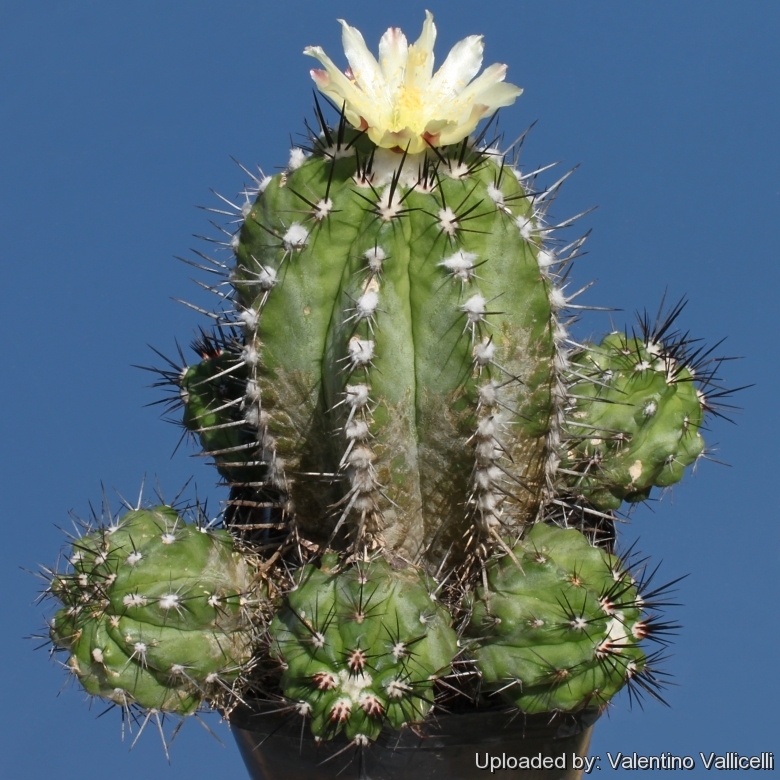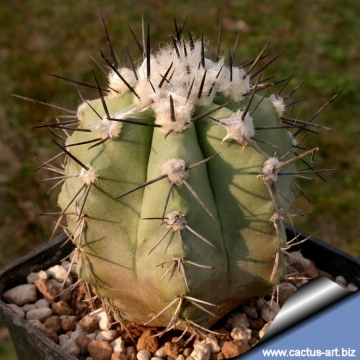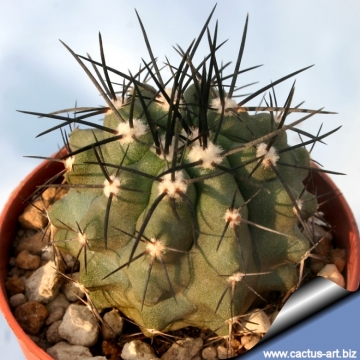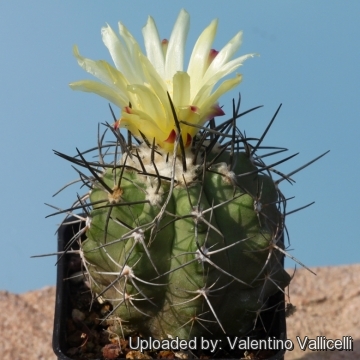Accepted Scientific Name: Copiapoa marginata (Salm-Dyck) Britton & Rose
Cactaceae (Britton & Rose) 3: 86 (1922). Britton & Rose

Copiapoa streptocaulon Photo by: Valentino Vallicelli
Origin and Habitat: Morro Copiapo, south-westerly from Caldera, on the north Chilean coast.
Synonyms:
See all synonyms of Copiapoa marginata
Description: Body upright, columnar-cylindrical, almost like a Cereus, forming a somewhat open clump.
Stem: Up to 50 cm tall, 7-10 cm in diameter, basally narrowed, grass-green to greys-green, crown blunt whit creamy-brown wool, which is in no way obscured by flowers
Ribs: 10-14, very sharp, broad obtuse, separated by broad intervals, neither tubercled nor notched up to 1 cm tall, straight.
Areoles: Rounded 0,5-1 cm in diameter, closely approaching each other or touching one another, young areoles with abundant grey or brownish wool, becoming ash-grey or black and bare in age.
Spines: Dark-brown becoming chalky-white as they ages. Spines clusters very closely set.
Radial spines: 5-7 strong, straight, spreading out in a ray, 1-2 cm long, the sideways or downwards pointing ones commonly the longest,
Central spines: 1 standing up vertically, very rigid, porrect, 2 to 3(-4) cm long (longer than the radials).
Roots: Conical-napifom root-stock, rapidly tapering with thick neck.
Flowers: 3 to 4 developing at a time, with characteristic Copiapoa flower-scent, sprouting out from the wool of the crown, yellow, scarcely standing out from the spines, when completely open only 2,5 to 3 cm in diameter, with lanceolate-spathulate perianth segments approx 15 mm long, 7 mm large, narrower below, rounded off above, pale yellow, the outermost reddish at the tips and expanded. Floral tube funnel-form 1-1.5 cm long, exterior with a few larger, greenish scales becoming red-brown above. Nectar chamber 3-5 mm. long, 3-4 mm wide half open. Filaments pale yellow, the lower ones 12 mm long, the upper 7-9 mm long, anthers citron yellow. Style 17-20 mm long, 2 mm thick, (longer than the stamens) with 9-15 rayed pale yellow stigma lobes, without any narrowing above the ovary.
Fruits: Small, 10 up to 12 mm long, 8 up to 12 mm broad, barrel shaped, (ovary 3 to 7 mm in diameter) pale green, or with a faint red tint, at the upper end greener or more reddish-brown, usually quite hairless and scale-less, or with few (1 or 3) red scales. Dehising from a lid-like top cracking when ripe.
Blooming season: Spring and summer.
Seeds: 1 mm long, 0,7 mm wide, 0,3 mm thick, black, somewhat shiny, with very small verrucae, hilum at the basal end inclined half ventral-wards, oval, white.
Notes: Systematically this species stands between Copiapoa duraSN|1414]]SN|14234]] which grows further to the south-east and Copiapoa bridgesiiSN|14234]]SN|1414]] which grows to the north.
Bibliography: Major references and further lectures
1) N. L. Britton, J. N. Rose “The Cactaceae. Descriptions and Illustrations of Plants of the Cactus Family.” Volume 4, The Carnegie Institution of Washington, Washington 1923
2) Edward Anderson “The Cactus family” Timber Press, Incorporated, 2001
2) Riha & Subik. “The illustrated encyclopedia of cacti and other succulents” (edited by G. & K.A. Beckett) 1981
3) Brickell, Christopher (1996). “Gardener's Encyclopedia of Plants & Flowers.” Colour Library Books. p. 443. ISBN 1-85833-472-1.
3) James Cullen, Sabina G. Knees, H. Suzanne Cubey “The European Garden Flora Flowering Plants: A Manual for the Identification of Plants Cultivated in Europe, Both Out-of-Doors and Under Glass” Cambridge University Press, 11/ago/2011
4) David R Hunt; Nigel P Taylor; Graham Charles; International Cactaceae Systematics Group. "The New Cactus Lexicon" dh books, 2006
5) Pfeiffer & Otto “Abbildung und Beschreibung Bluehender Kakteen” 2: t. 30 1850
6) Graham Charles “Copiapoa” Cirio Pub. Services, 1999
4) Friedrich Ritter - Kakteen in Südamerika (Ergebnisse meiner 20jährigen Feldforschungen) 1980
 KK72 Cerro Moreno, Antofagasta, Chile, 600 m. Photo by: Cactus Art
KK72 Cerro Moreno, Antofagasta, Chile, 600 m. Photo by: Cactus Art Copiapoa streptocaulon Photo by: Cactus Art
Copiapoa streptocaulon Photo by: Cactus Art Copiapoa streptocaulon Photo by: Cactus Art
Copiapoa streptocaulon Photo by: Cactus Art Copiapoa streptocaulon Photo by: Valentino Vallicelli
Copiapoa streptocaulon Photo by: Valentino VallicelliCultivation and Propagation: Considering that Copiapoa streptocaulonSN|9826]]SN|9826]] comes from a habitat with an extremely arid climate, they are remarkably tolerant of pot culture. These plants have thick taproots and are susceptible to overwatering. They requires also an appropriate air circulation. Copiapoas are summer grower species easy to cultivate
Growth rate: This is a slow growing cactus kept for the beauty of its form that will make clumps given the best conditions.
Soils: It likes very coarse mineral cactus mix soil, but can become too elongated if compost is too rich.
Repotting: Use pot with good drainage.
Watering: It requires light but regular waterings in summer, but let the soil mix dry between waterings, but do not overwater (Rot prone), it must be strictly kept dry throughout the winter quiescent period since it is very sensitive to any moisture excesses keep dry in winter.
Fertilization: Feed with a high potassium fertilizer in summer.
Hardiness: Not highly tolerant of a great deal of frost.They need to be kept in a cool place during winter rest and are resistant to light frost if kept on the dry side prior to, and during, cold weather ( they are hardy to -2 C ° C short periods). However some warmth throughout the year will increase the grower's success (minimum 5° to 10°C during rest season).
Exposition: Requires full sun or light shade and careful watering to keep plant compact with strong coloured spines. Tends to bronze in strong light, which encourages flowering and heavy spine production. Light shadow my be useful in the hottest summer days.
Uses: It is an excellent plant for container growing. It always looks good and stays small. It look fine in a cold greenhouse and frame or outdoor in a rockery.
Pests & diseases: It may be attractive to a variety of insects, but plants in good condition should be nearly pest-free, particularly if they are grown in a mineral potting-mix, with good exposure and ventilation. Nonetheless, there are several pests to watch for:
- Red spiders: Red spiders may be effectively rubbed up by watering the infested plants from above.
- Mealy bugs: Mealy bugs occasionally develop aerial into the new growth among the wool with disfiguring results, but the worst types develop underground on the roots and are invisible except by their effects.
- Scales: Scales are rarely a problem. It is wise to treat your whole collection with a systemic insecticide twice a year in spring and autumn.
- Rot: Rot is only a minor problem with cacti if the plants are watered and “aired” correctly. If they are not, fungicides won't help all that much. To prevent rottenness it is also advisable to surround its root neck by very rough sand or grit, this help a fast water drainage.
Propagation: Seeds (or offsets if available), Grafting is often used to speed growth rate and to create a back-up to plants in collection. Seeds germinate in 7-14 days at 21-27° C in spring, remove gradually the glass cover as soon the plants will be well rooted (ca 1-2 weeks) and keep ventilated, no full sun for young plants!














